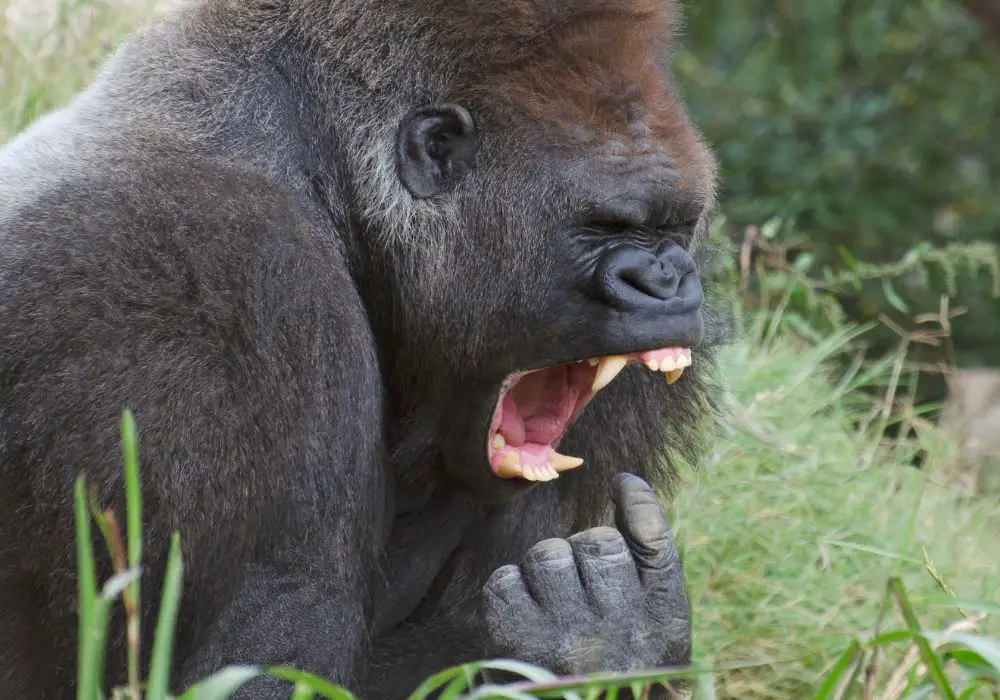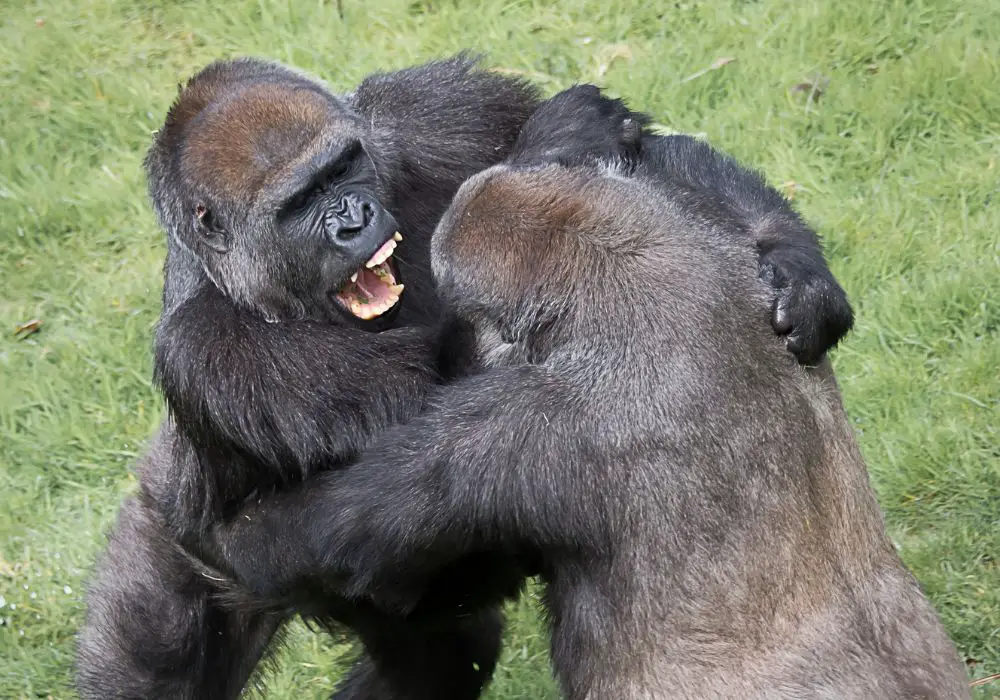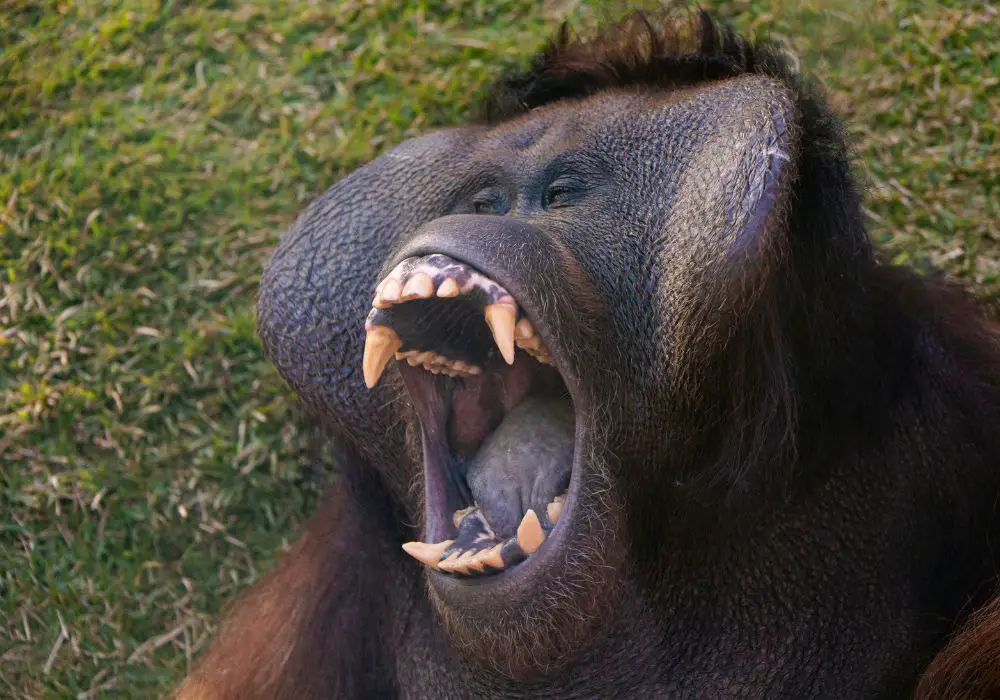Gorillas are the largest living primates on Earth. They are characterized by their massive bodies, broad chests, large hands and feet, and most noticeably, their oversized jaws and teeth. An adult male gorilla’s enormous canine teeth can reach up to 2 inches (5 cm) in length, while their molars have wide, flat surfaces built for grinding coarse vegetation. Their impressive dentition is specially adapted for their strict herbivorous diet. But why did gorillas evolve to have such gigantic teeth compared to other great apes like chimpanzees or humans? Several key factors related to their diet, environment, and social structure drove the evolution of gorillas’ mega dentition.
Dietary Adaptations
A gorilla’s massive teeth and chewing power are vital adaptations for their low-quality fibrous diet. Gorillas are folivores, specializing in eating large quantities of leaves, pith, bark and woody stems. These coarse plant materials are difficult to breakdown and digest due to the high fiber content. Gorillas spend over half their daily feeding time (68%) consuming and processing this poor-quality vegetation. To effectively extract nutrients, gorillas need specialized teeth and an efficient chewing apparatus.
Gorillas have particularly large premolars and molars, which serve as the engine for grinding up tough vegetation. Their molars have increased ridges, cusps and crests compared to other apes。 This expanded occlusal surface area enhances shearing and crushing capacity to pulverize thick plant cell walls. The molars also have high crowns to add chewing surface and prevent excess wear from abrasive plants. In addition, the giant incisors and canines at the front of a gorilla’s jaw are useful for initially tearing and preparing bulky food prior to mastication. The massive canines help strip fibrous foliage off of stems and peel back bark to access the more nutrient-rich inner pith. Gorillas adeptly use their 2 inch canines like bolt cutters to sheer through mature bamboo stalks and other woody vegetation. The size, morphology and positional arrangement of gorilla teeth work in coordination to maximize the breakdown of indigestible vegetation.
Gorillas spend up to 12 hours per day consuming over 40 pounds of food on average. Their expansive oral processing equipment and chewing power is essential to meeting their high intake needs. In terms of digesting fiber, gorillas have an enlarged sacculated colon to ferment and absorb nutrients from their herb-based diet. Their gut also adapts by elongating in the rainy season when more fibrous foods are consumed. But without their specialized dentition, gorillas would lack the initial mechanical breakdown required for their gut to digest such huge volumes of coarse vegetation. The remarkable adaptation of gorilla mega-herbivore teeth is driven by the demands of their low-quality fibrous diet.
Environmental Influences

In addition to dietary necessities, gorilla tooth adaptations are also shaped by their tropical forest habitat. As terrestrial herbivores, gorillas inhabit the dense understory of rainforests in equatorial Africa. These habitats contain abundant woody vines, celery-like herbs, bamboo and other seedlings and saplings with tough lignified stems. The high proportion of woody vegetation in their native environment requires enhanced chewing capacity and dental specializations to breakdown indigestible plant fibers. Access to higher quality fruit is also seasonally limited in their habitat. Thus, the year-round reliance on poor-quality fibrous herbs and shoots selected for advanced chewing teeth.
Some gorilla populations reside at high mountain elevations up to 13,000 feet. The cool high-altitude environments produce vegetation with even thicker cell walls and heavily lignified stems. This increases the chewing resistance and difficulty of breakdown. Therefore, the cold mountainous rainforest habitats occupied by certain gorillas imposed selection pressures for further enlargement of chewing teeth with greater shear-cutting ability. The regional environments and specific vegetation properties influenced local adaptations of extreme tooth size and morphology in gorillas.
In contrast, chimpanzees inhabit more open and drier woodlands and gallery forests. They have access to more soft fruits in addition to leaves, seeds and bark. Accordingly, chimp teeth are smaller with different molar crests better suited for both leaves and fruit. The unique rainforest environment and fibrous herb-dominated diet of gorillas drove specific dental modifications not seen in their close frugivorous relatives. Gorilla tooth enlargement and design evolved in tandem with their specialized ecological niche.
Social Structure

A final factor contributing to gorilla mega-dentition is social behavior, particularly male competition. Gorillas have a polygynous social structure centered around an dominant silverback male. The large intimidating silverback has primary sexual access to females in his harem and high rank in the group hierarchy. His leadership depends on physical superiority to deter rival males. Younger blackbacks periodically challenge the silverback attempting to take control of the group. Therefore, intense male-male competition exists over reproduction and status.
The need for the silverback to threaten sexual rivals seems to have selected for enlarged upper and lower canine teeth. A silverback’s prominent 2 inch canines likely evolved to enhance displays of aggression and fighting ability. Impressive canines allow a silverback to look more menacing during disputes over hierarchy and intimidate adversaries. In serious violent encounters, male gorillas do bite opponents and can inflict severe injuries with their dagger-like canines. More dominant, battle-scarred silverbacks tend to have particularly long canine teeth compared to less competitive males. Besides diet and habitat, social behavior and sexual selection pressure to dominate rivals also contributed to the dramatic elongation of gorilla canine teeth.
Comparisons with Other Species
The extreme tooth size and chewing adaptations of gorillas stands out in comparison to other primates including nearby great ape relatives. Our closest primate relatives, chimpanzees, have much smaller canines and lesser cheek tooth crests. This aligns with their more frugivorous diet composed predominantly of soft ripe fruit rather than leafy vegetation. The predominantly folivorous orangutan has intermediate sized molars better suited for bark, seeds and some leaves. But they use tools to access insect protein and have longergaps between births, reducing pressure for digesting large fibrous volumes. Our own small human teeth demonstrate a trade-off as cooking and food processing reduces need for internal mechanical breakdown. The dramatic enlargement of gorilla teeth exemplifies specialized adaptations exceeding all other great apes.
Tooth trait comparisons between gorillas and other primates
| Species | Tooth size | Diet | Major tooth adaptations |
|---|---|---|---|
| Gorilla | Very large | Fibrous vegetation | Enormous flat molars, giant canines |
| Chimpanzee | Moderate | Mainly ripe fruit | Lesser molar crests |
| Orangutan | Intermediate | Fruit and some leaves | Generalized grinding teeth |
| Human | Very small | Variety, cooked food | Greatly reduced chewing needs |
Table showing relative tooth size and primary diet correlates with key dental adaptations in great apes
Frequently Asked Questions

Why do gorillas have such large canine teeth?
Gorillas have exceptionally large canine teeth compared to other apes. The big canines likely evolved for both male competition and food processing. They are used for displays of aggression between males fighting for status. The canines also aid in stripping tough vegetation and accessing inner bark and stems.
How much bigger are gorilla teeth compared to human teeth?
On average, gorilla teeth are about 2 to 3 times larger than human teeth. Molar teeth have roughly double the surface area. The canines can reach 2 inches long in a male gorilla, whereas human canines are usually less than 1 inch.
How many teeth do gorillas have?
The gorilla dental formula is the same as other great apes, containing 32 permanent teeth. There are 4 incisors, 2 canines, 4 premolars, and 6 molars in each half of the upper and lower jaws, totaling 32 teeth.
Why are gorilla jaws so large and muscular?
Gorillas have very large, robust jaw muscles and broad jaws to support their massive teeth. Powerful jaw muscles allow them to generate tremendous chewing force. This enables more efficient grinding of fibrous plant material. Their wide jaws provide a large surface area for anchoraging huge chewing muscles.
How do the teeth of gorillas compare to other herbivores?
Unlike grazing herbivores like cattle, gorilla teeth are adapted for browsing on fibrous vegetation. Gorilla molars have increased ridges rather than a flat grinding surface like in grazers. The canines are also much longer for initial food processing. But similar to grazers, gorillas have big chewing teeth with increased enamel to withstand wear from abrasive plants.
Conclusion
In summary, gorillas require impressive teeth in order to subsist on large amounts of fibrous plant material. Their massive premolars and molars with expanded ridges and cusps provide enhanced grinding capacity to breakdown tough vegetation. The oversized canines assist with initial food preparation and serve as weapons for competing males. These remarkable dental attributes evolved due to the unique ecology of gorillas as terrestrial folivores in tropical rainforests. Their strictly herbivorous diet composed mainly of coarse leaves and stems demanded specialized chewing adaptations. When compared to other great apes, the dramatic enlargement of gorilla dentition exemplifies the result of selective pressures and specialized adaptation to their herb-dominated ecological niche. Given their essential role in survival and reproduction, the incredible teeth of gorillas are truly an evolutionary marvel.






